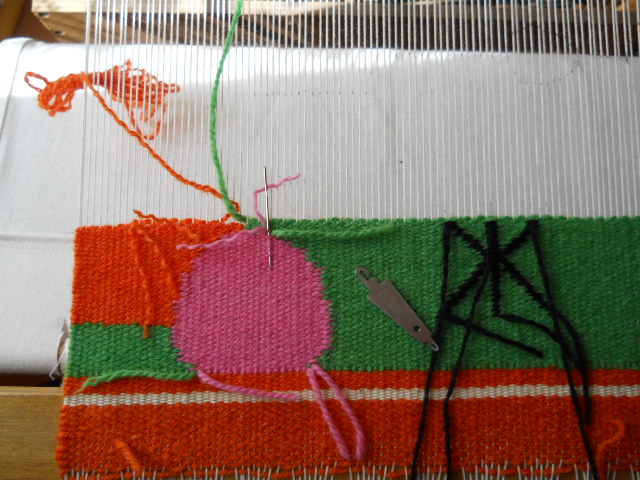LaDonna Mayer Tapestry
Tapestry is a complicated art form. Tapestry artists weave their "canvases" as they go. There are several ways to weave a tapestry. I weave Aubusson style, basse lisse, from the back side of the tapestry on horizontal floor looms. This is my process:
Fine Art Tapestries

First, the design is drawn, then enlarged to an actual size cartoon. The cartoon is then transferred to tracing paper or mylar film. The colors of yarn are chosen and taped to the enlarged cartoon.
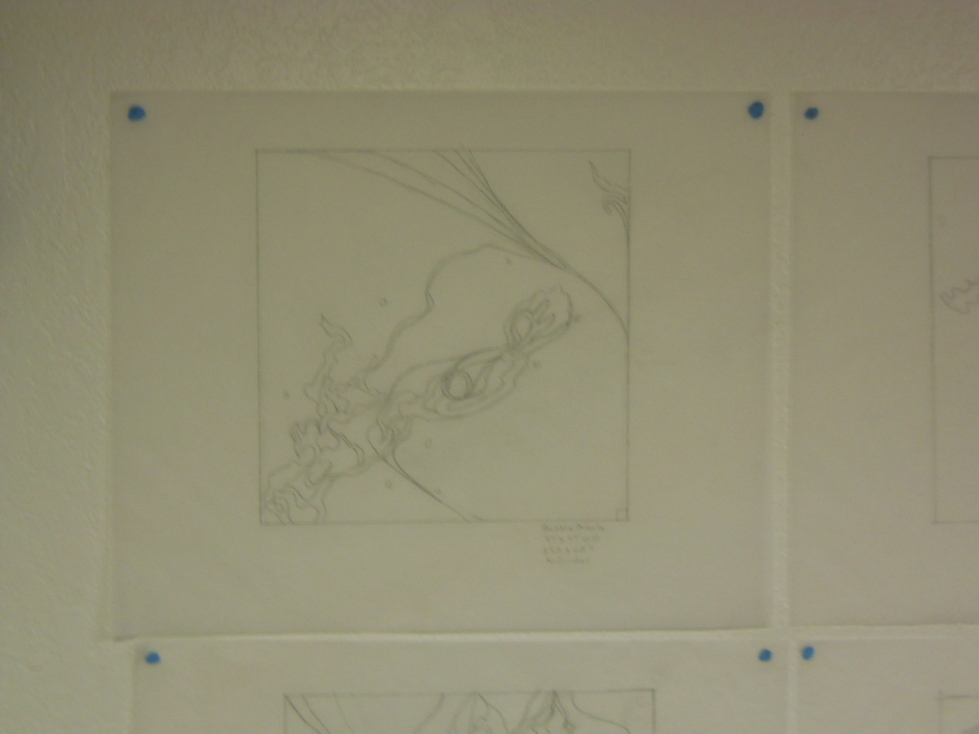
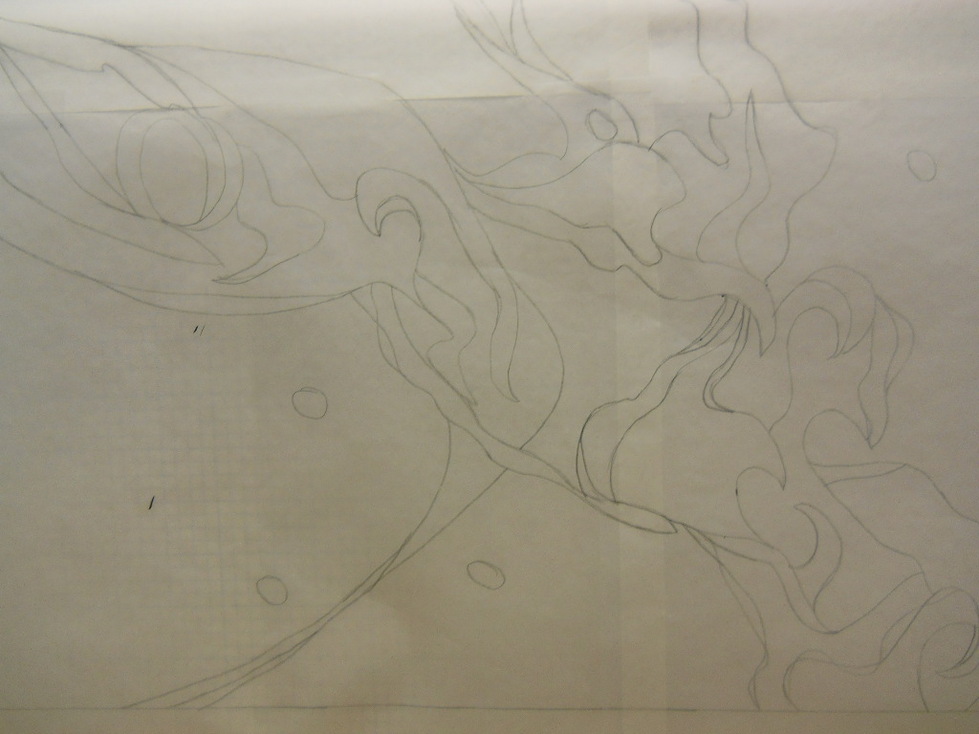
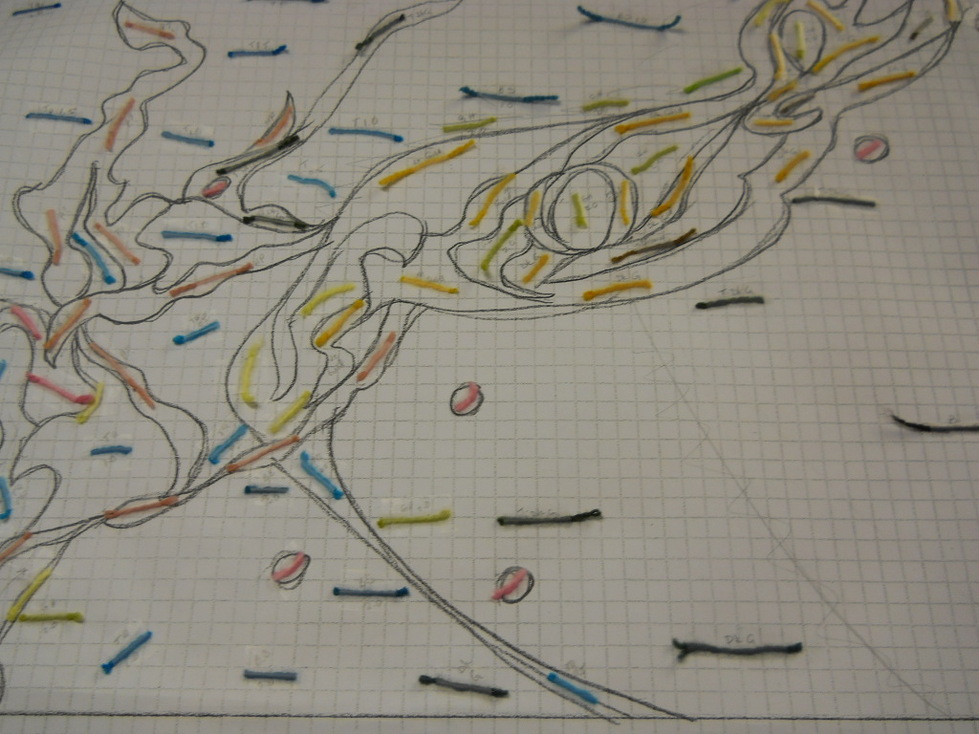
Original design
9.5" x 9.5"
9.5" x 9.5"
Enlarged cartoon on tracing paper
reversed
28.5" x 28.5"
reversed
28.5" x 28.5"
Enlarged cartoon with color
28.5" x 28.5"
28.5" x 28.5"
Next, the warp is measured and the loom is dressed.
A wide header is woven to even out the distance between all of the warp threads. Once the threads are properly spaced a small hem of the warp thread material is woven. Then a hem of the actual weft yarn is woven. After this hem is woven a row of soumac knots of the same weft yarn is tied across the whole width of the warp. This is to prevent the warp threads from showing when the hems are turned under. It also helps to keep the warp evenly spaced.
A wide header is woven to even out the distance between all of the warp threads. Once the threads are properly spaced a small hem of the warp thread material is woven. Then a hem of the actual weft yarn is woven. After this hem is woven a row of soumac knots of the same weft yarn is tied across the whole width of the warp. This is to prevent the warp threads from showing when the hems are turned under. It also helps to keep the warp evenly spaced.
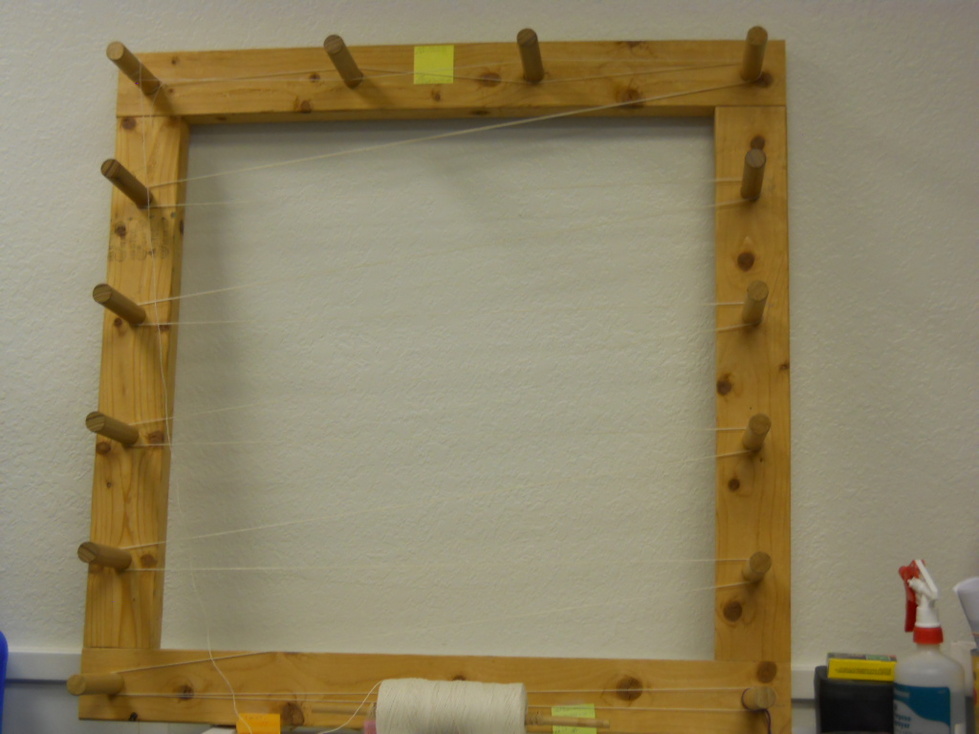
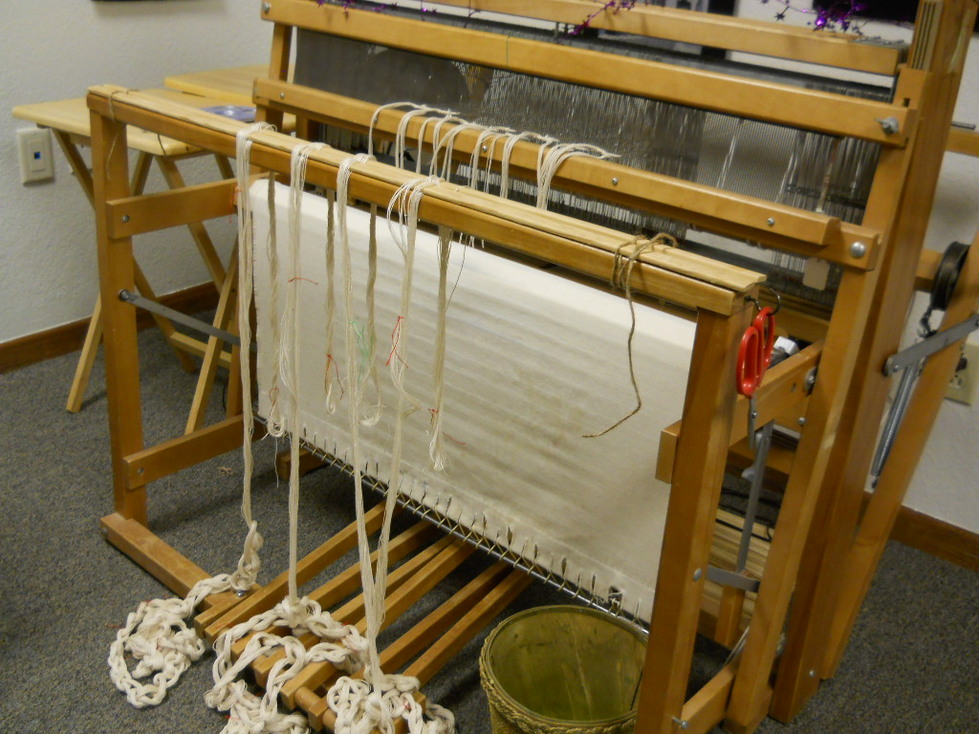
Measuring warp on the warping board
Dressing the loom
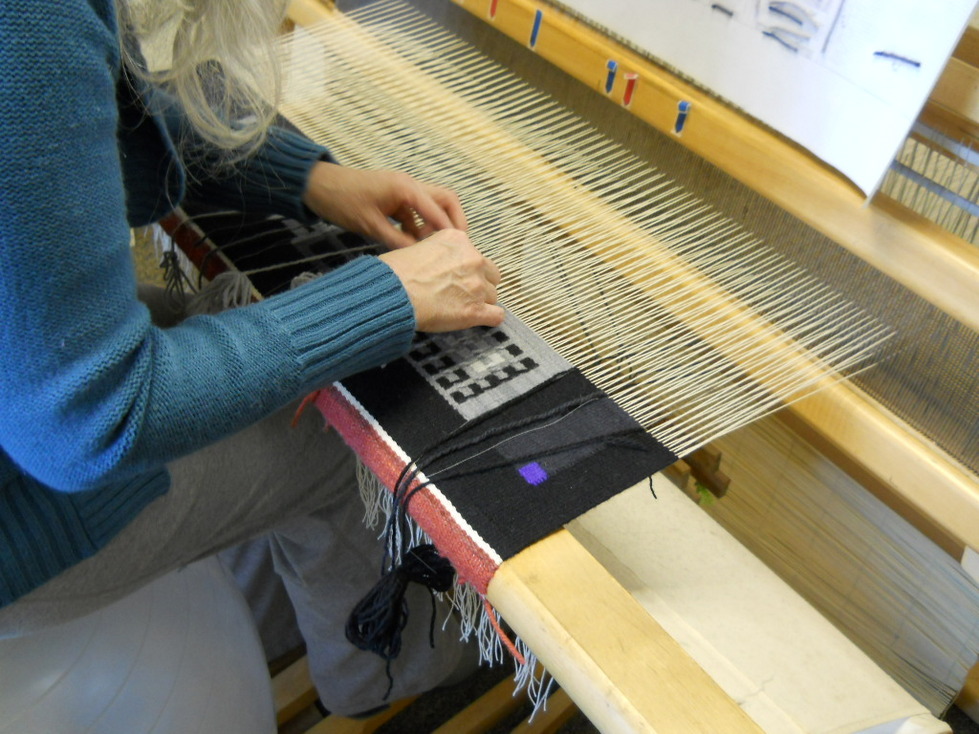
Red header, white hem, black hem
When the hems and knots are in place the transparent cartoon is then pinned under the warp, face down.
The image is dotted onto the warp threads with permanent marker, then the cartoon is removed from the warp. Only a few inches at a time can be dotted.
As the piece is woven it is rolled onto the front roller beam, the cartoon is re-attached to the warp and a few more inches are dotted. Since only a few inches of the woven tapestry can be seen at any given time the cartoon is essential to keeping it on course.
The image is dotted onto the warp threads with permanent marker, then the cartoon is removed from the warp. Only a few inches at a time can be dotted.
As the piece is woven it is rolled onto the front roller beam, the cartoon is re-attached to the warp and a few more inches are dotted. Since only a few inches of the woven tapestry can be seen at any given time the cartoon is essential to keeping it on course.
The weft yarn is bubbled across the warp.
In the weaving process the weft yarn doesn't just go through the shed, the raised and lowered warp threads. It must go over or under each thread as well, to completely cover the warp. Too much bubbling makes the surface uneven and makes the edges (selvedges) bulge out. Too little bubbling lets the warp show through and pulls in the selvedges. In order to get perfectly straight edges the bubbling must be perfectly balanced.
In the weaving process the weft yarn doesn't just go through the shed, the raised and lowered warp threads. It must go over or under each thread as well, to completely cover the warp. Too much bubbling makes the surface uneven and makes the edges (selvedges) bulge out. Too little bubbling lets the warp show through and pulls in the selvedges. In order to get perfectly straight edges the bubbling must be perfectly balanced.
Cartoon pinned under warp
Dotting the warp
Bubbling the weft
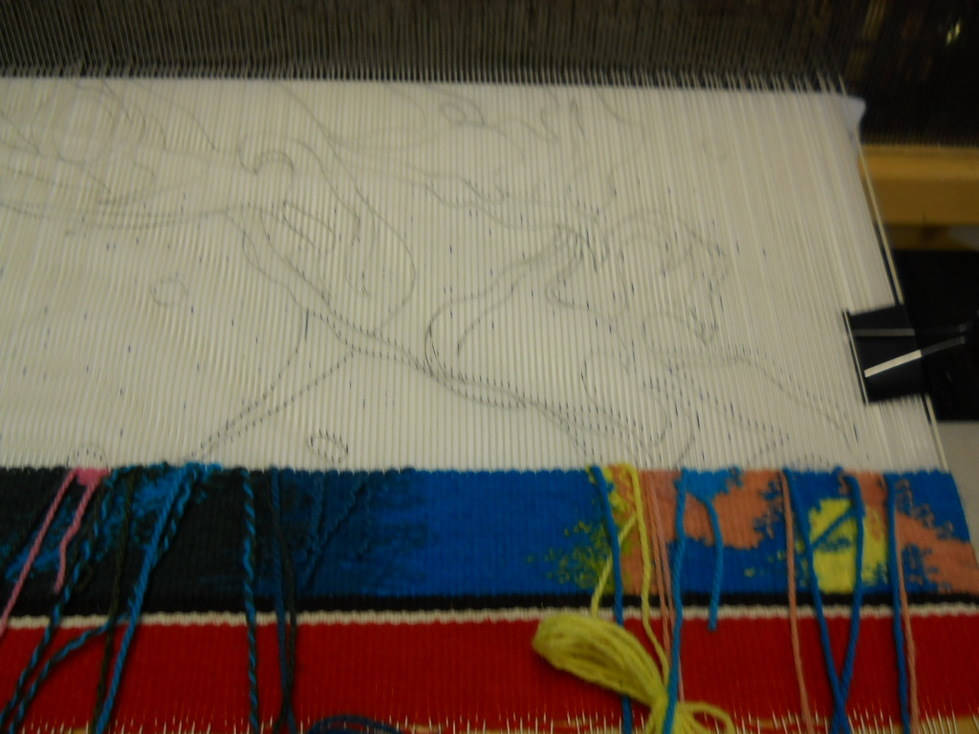
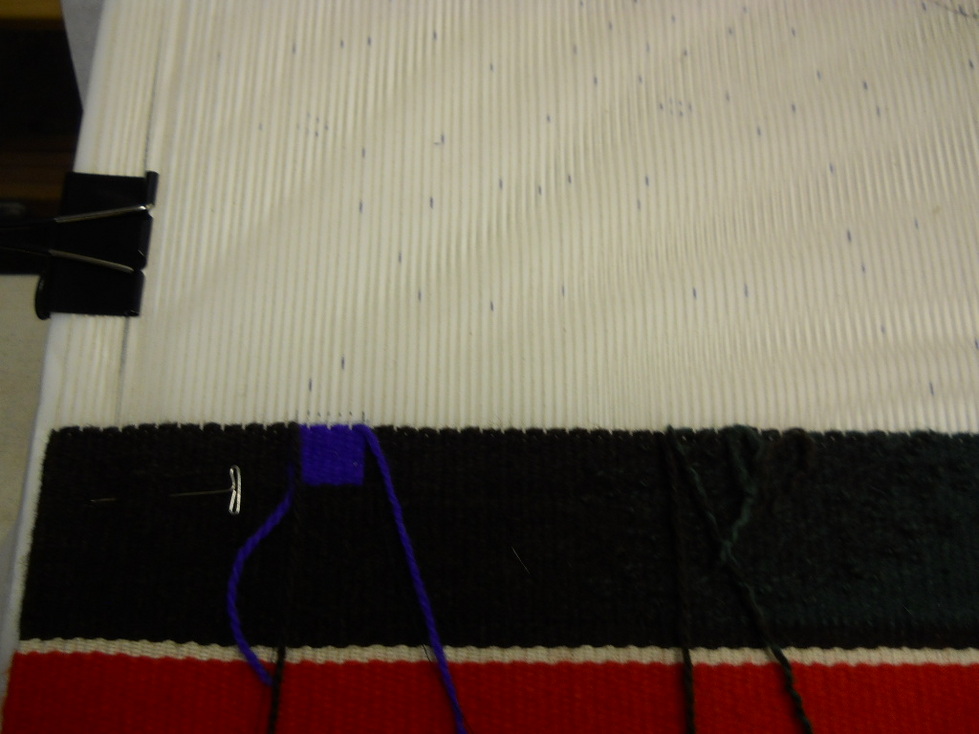
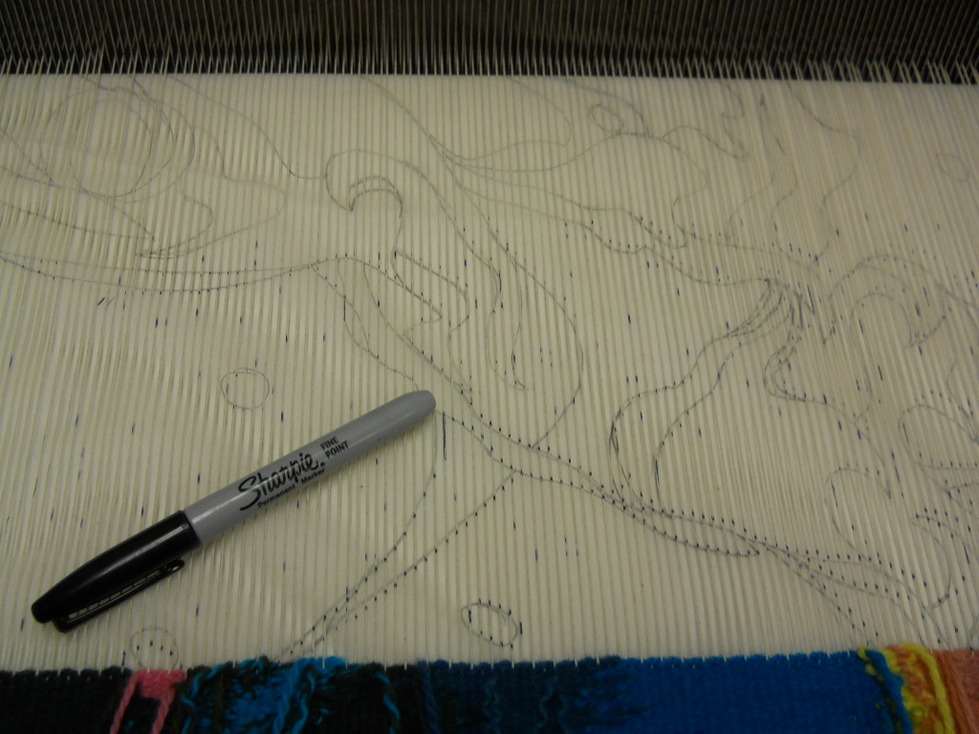
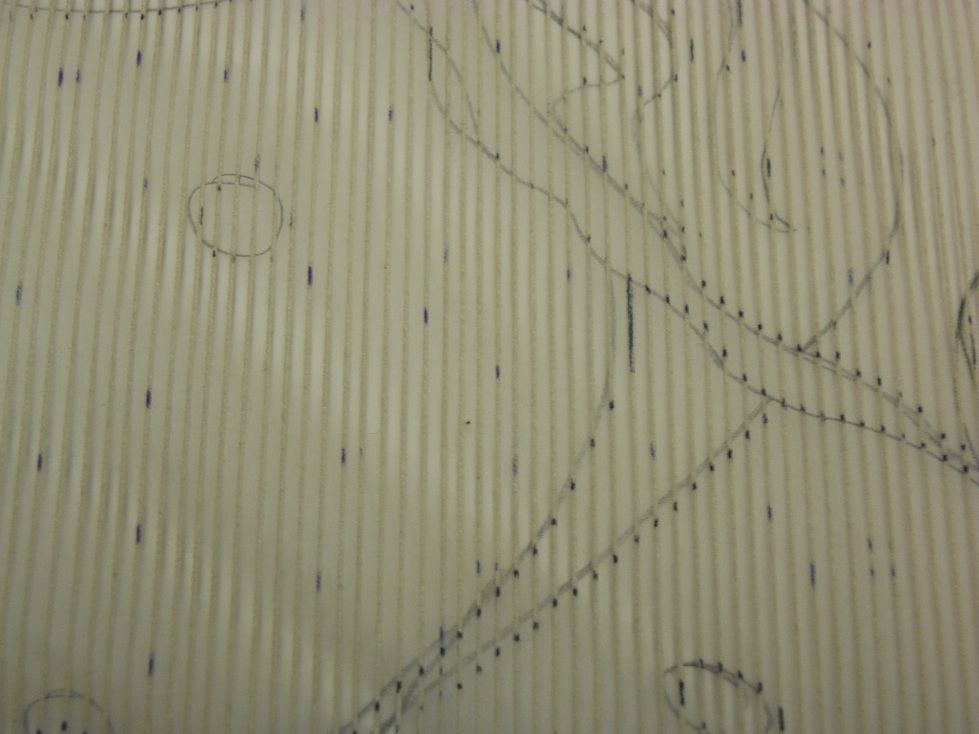
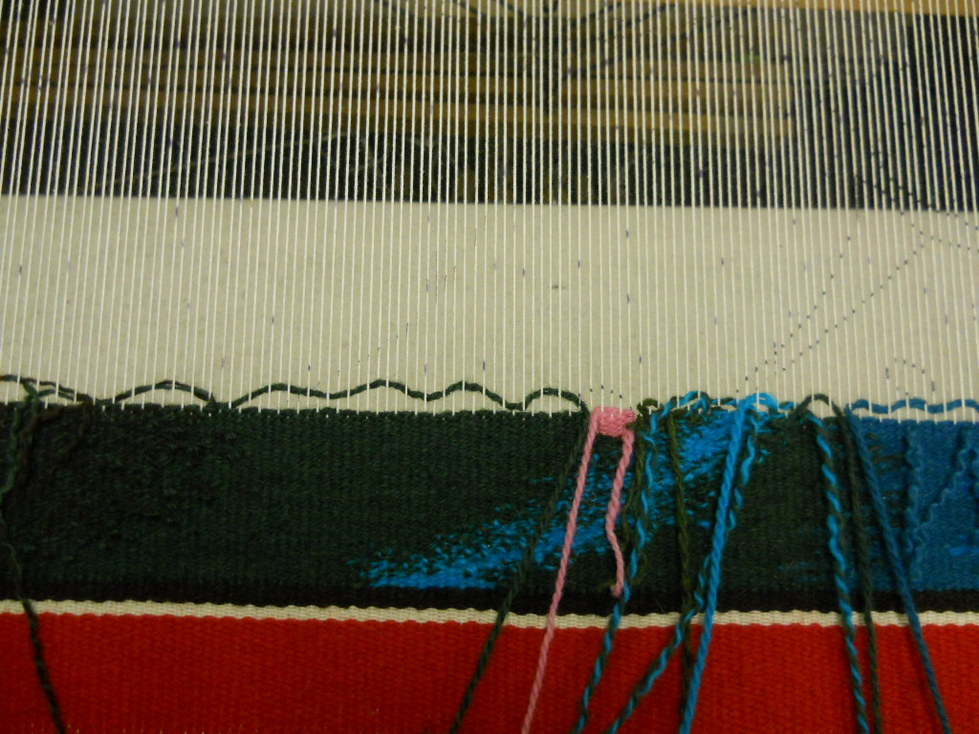
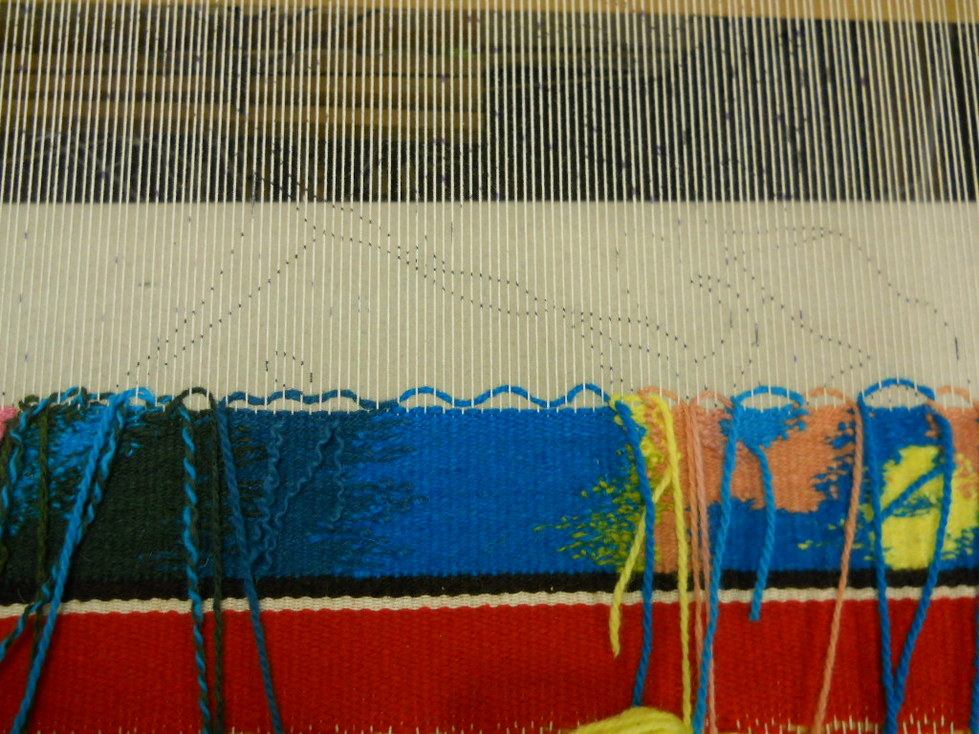
The weaving process is slow and methodical. It takes several months to weave a large tapestry. This image is the beginning of "Jazz Dancer 1", 34"x 53.25" (see Spirit Dancers page). The tapestry had over 200 hours of weaving and twelve hours of finishing. These hours do not include setting up the warp, creating the design, drawing and enlarging the cartoon, dyeing the yarns and mounting the piece.
"Jazz Dancer 1" used 868 yards of 12/6 Swedish cotton warp and over 9,000 yards of Swedish singles wool weft. All of the wool was hand dyed with Lanaset acid dyes for colorfastness.
"Jazz Dancer 1" used 868 yards of 12/6 Swedish cotton warp and over 9,000 yards of Swedish singles wool weft. All of the wool was hand dyed with Lanaset acid dyes for colorfastness.
Finishing and mounting the tapestry takes time and patience.

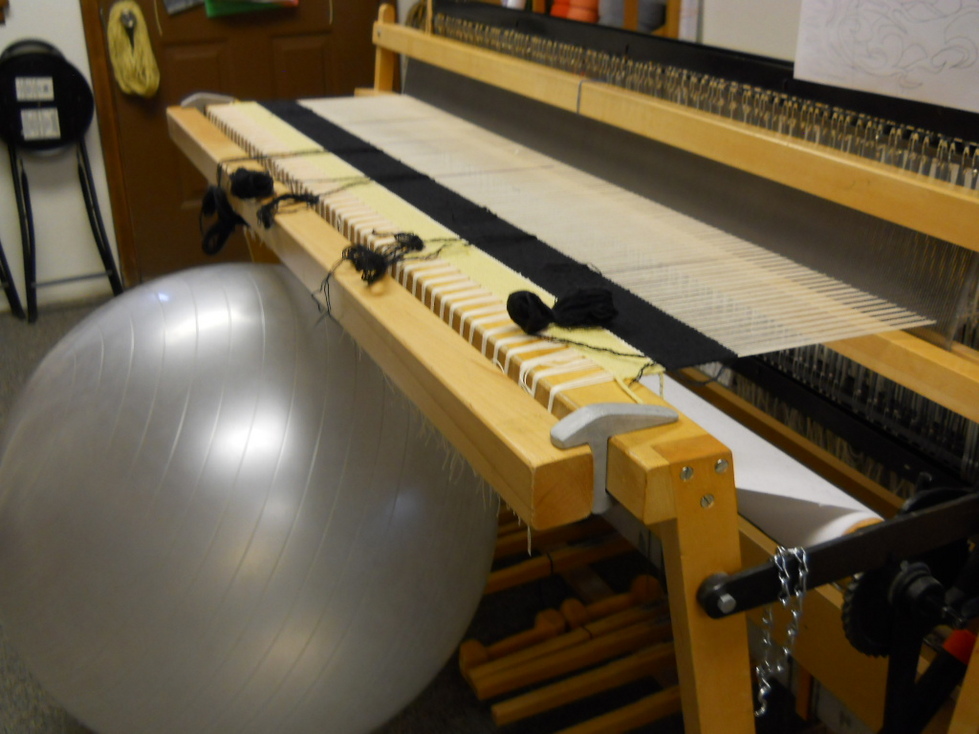
Cutting off:
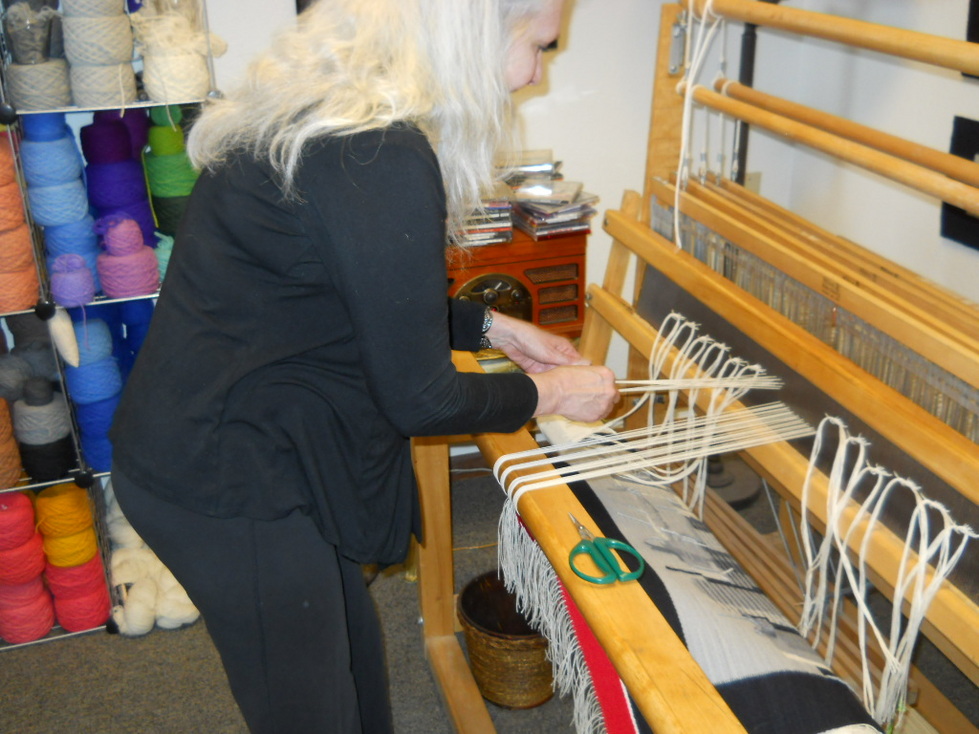
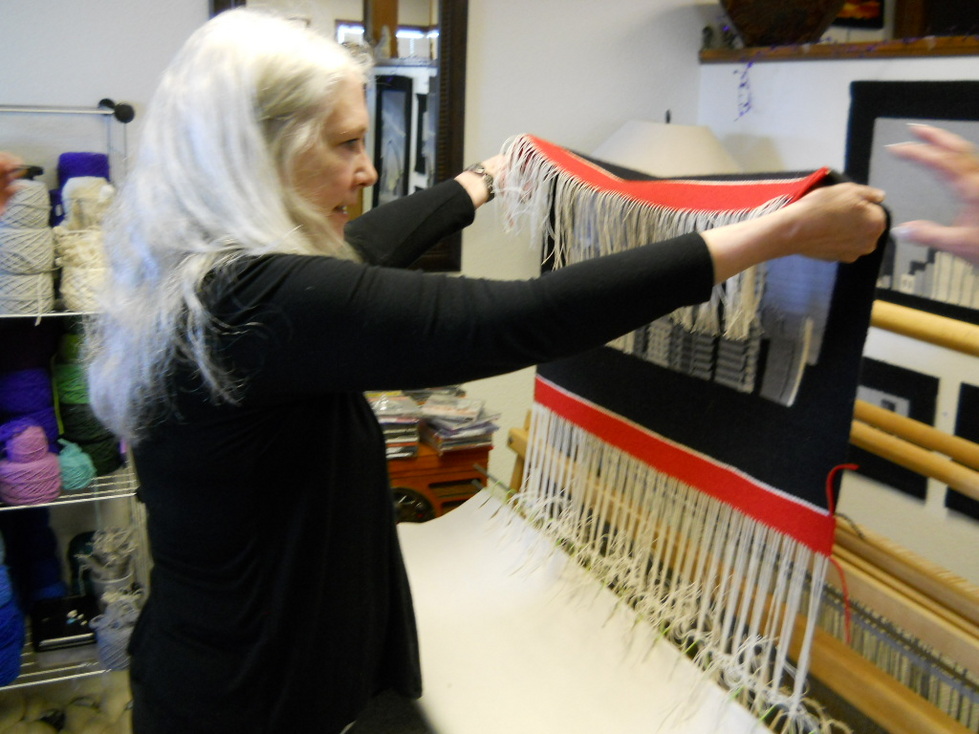
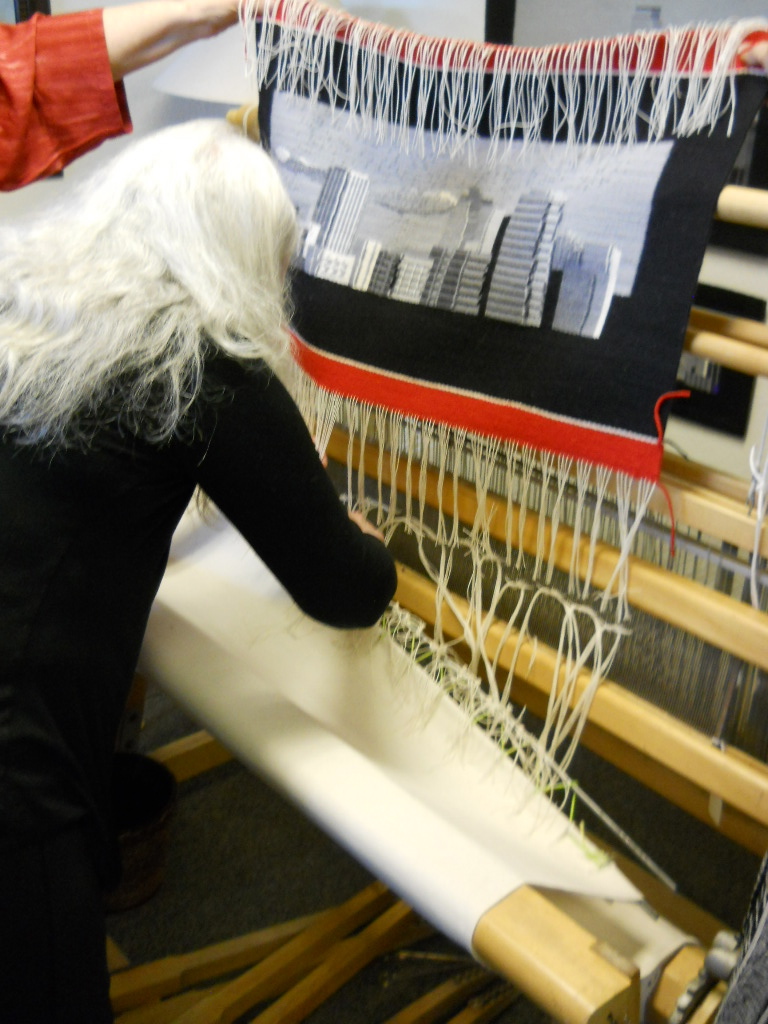
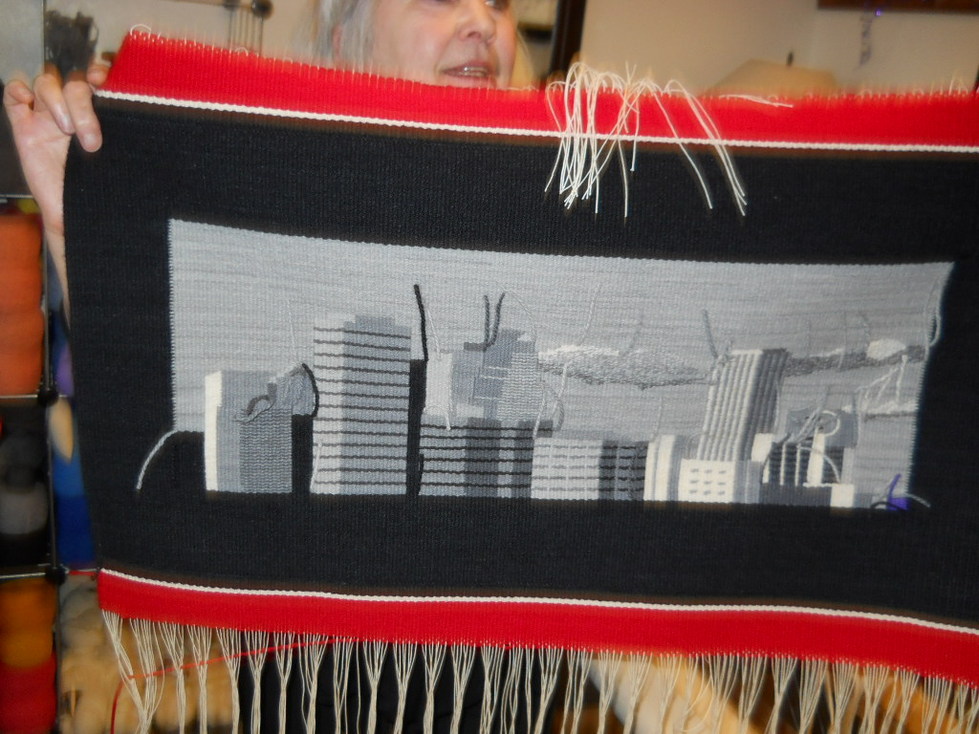
The Dye Process:
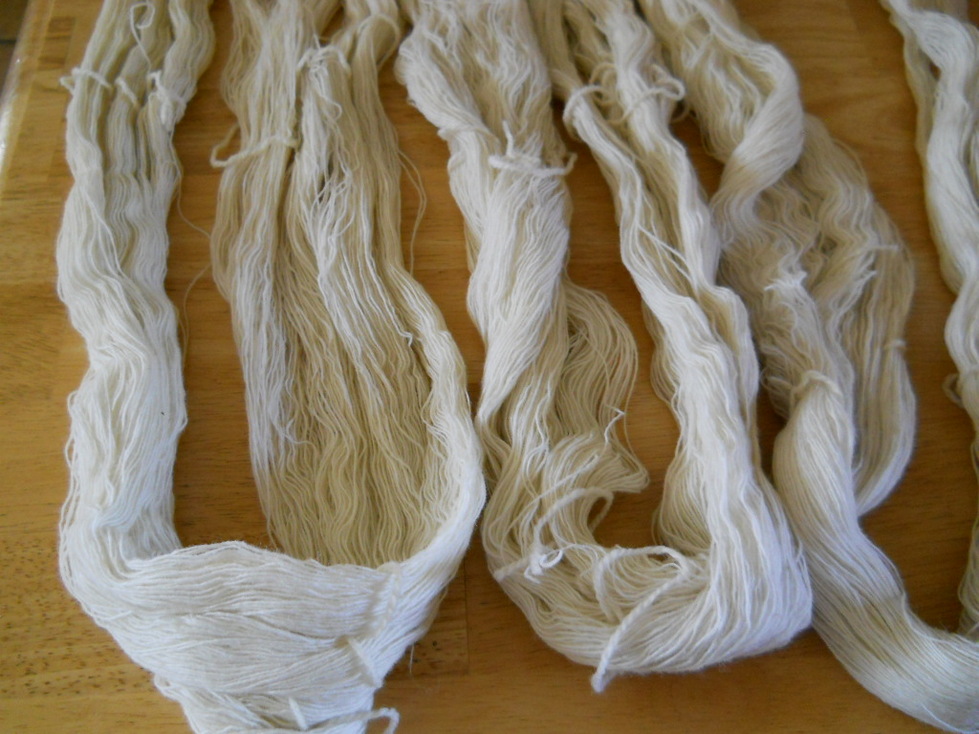
Skeins tied for dyeing
Tying skeins
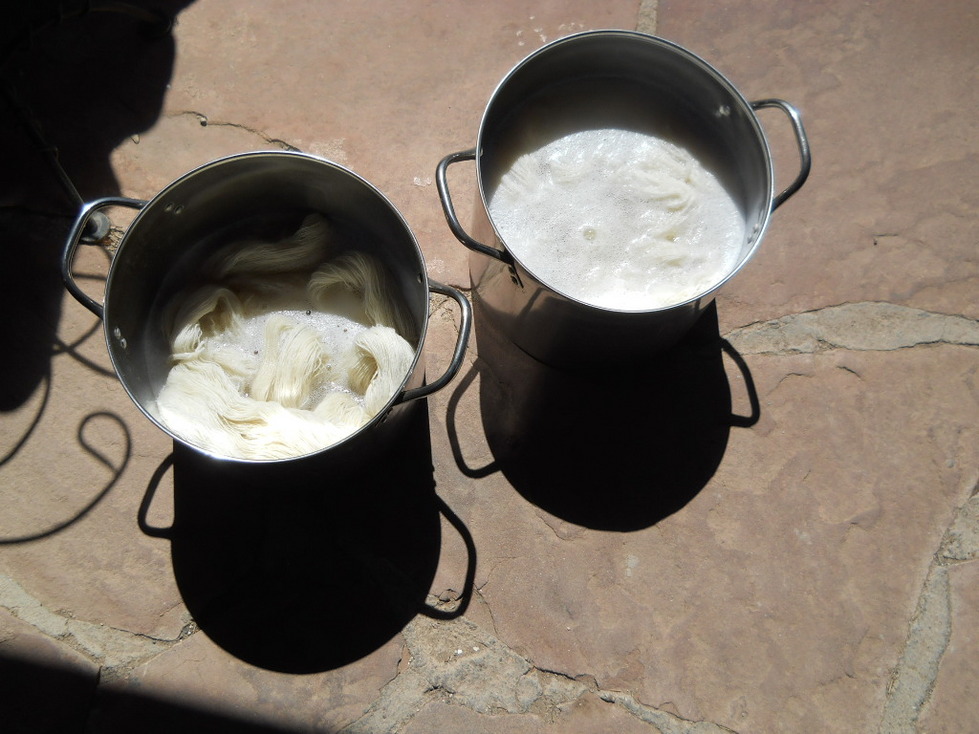
Soaking the wool
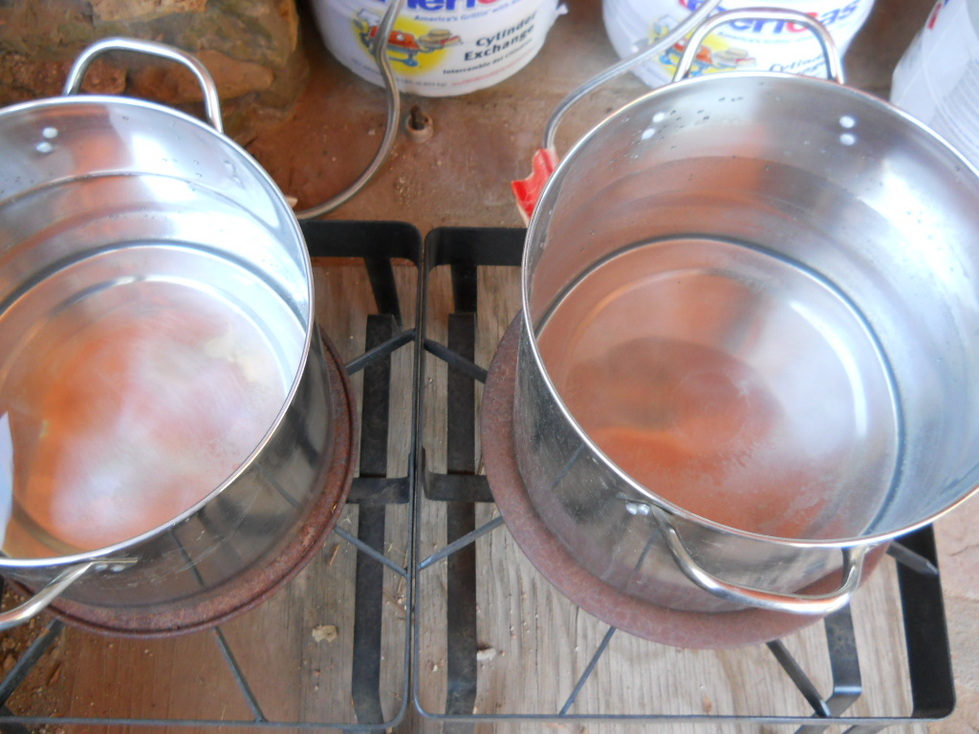
Dye pots with water (note: porch ceiling red reflected in water)

Tools of the trade w/
dye solution
dye solution
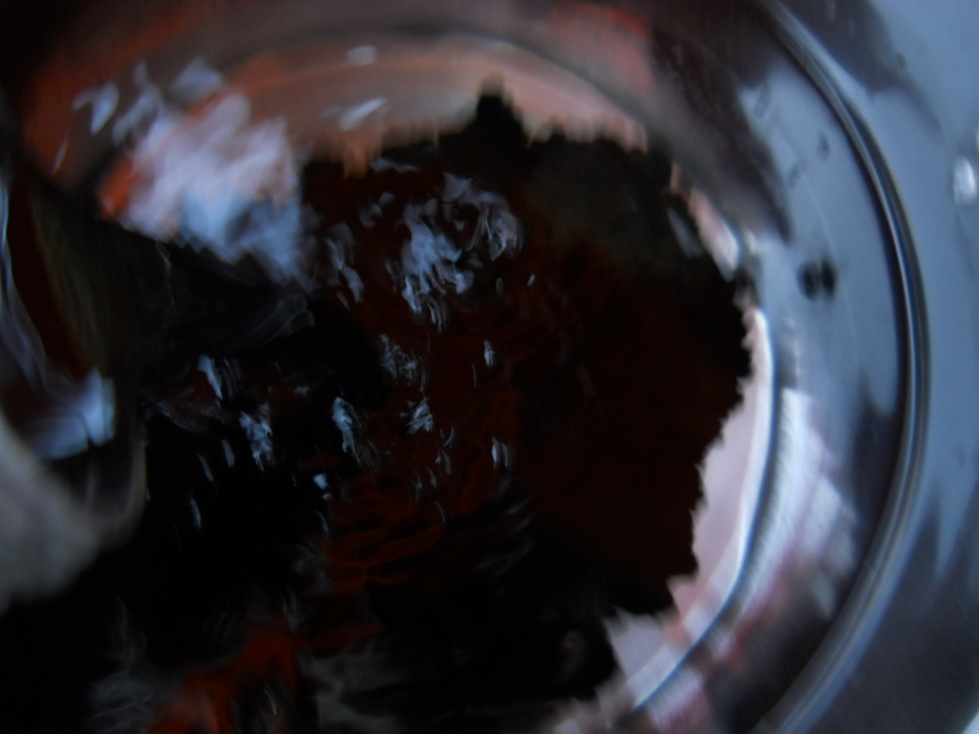
Adding dye solution
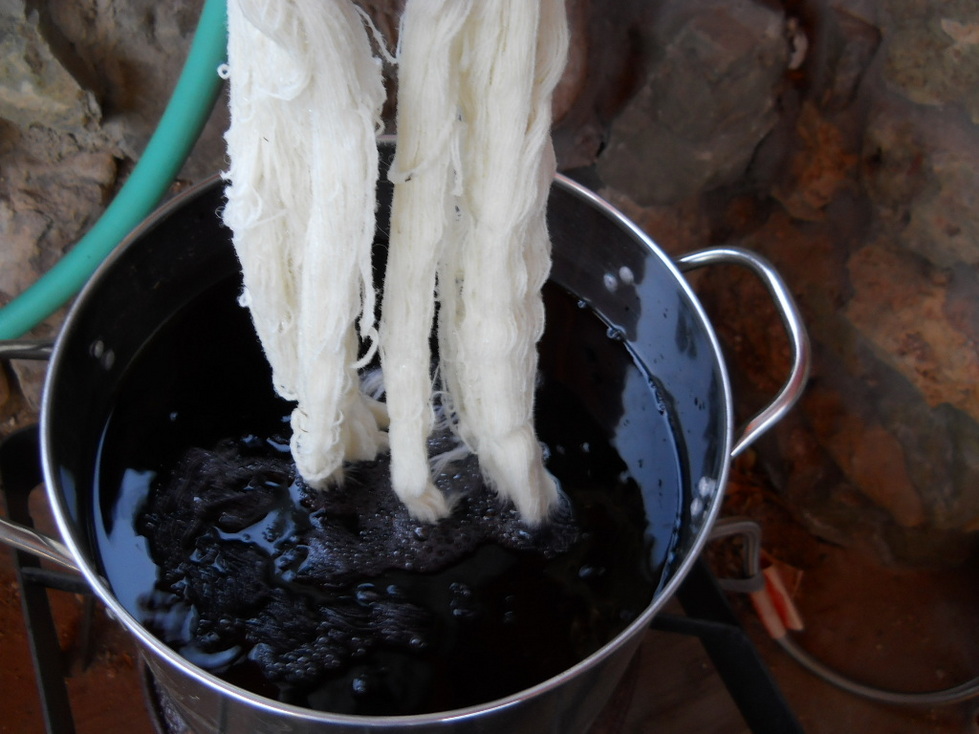
Adding wet wool to the dye pot
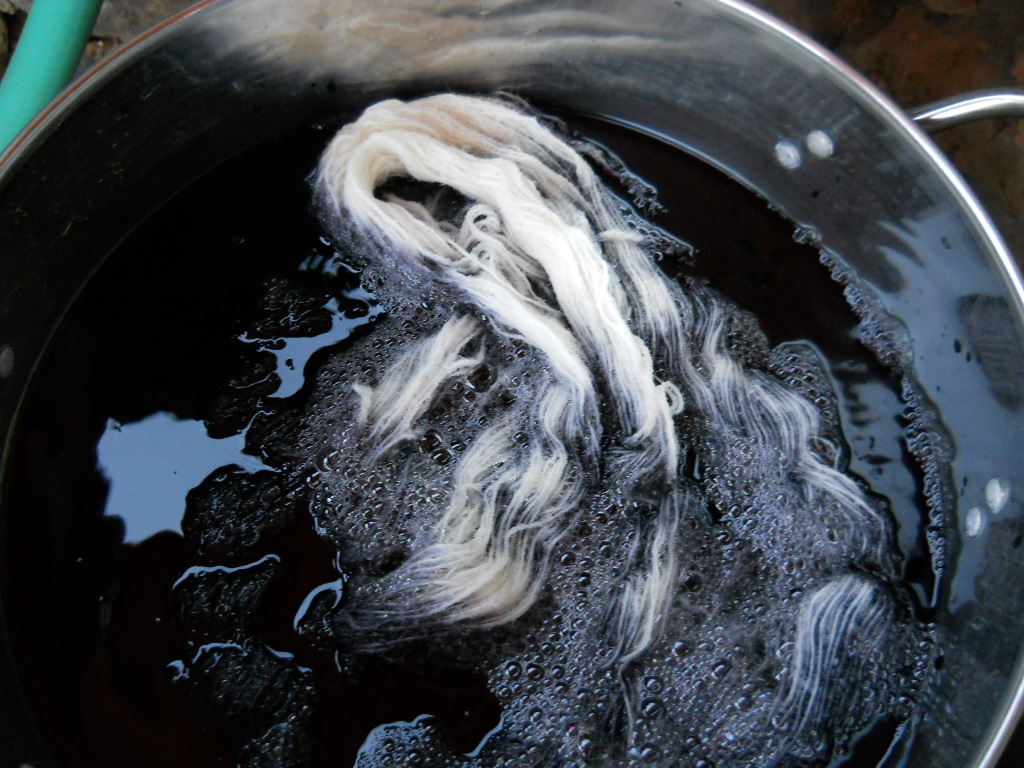
Absorbing dye
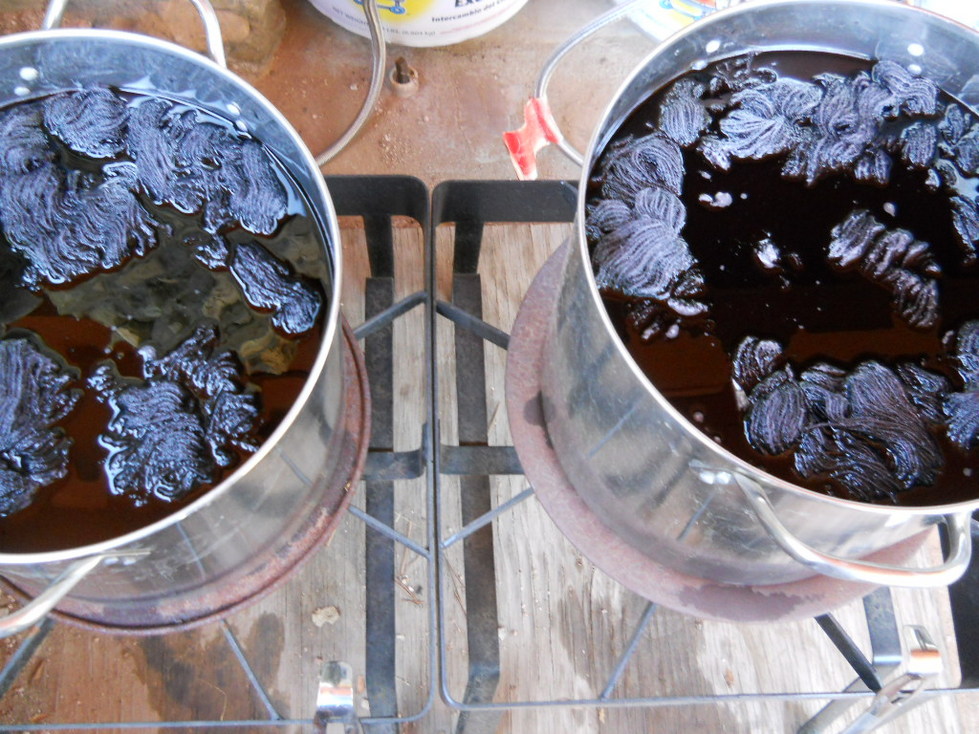
Turn on the heat
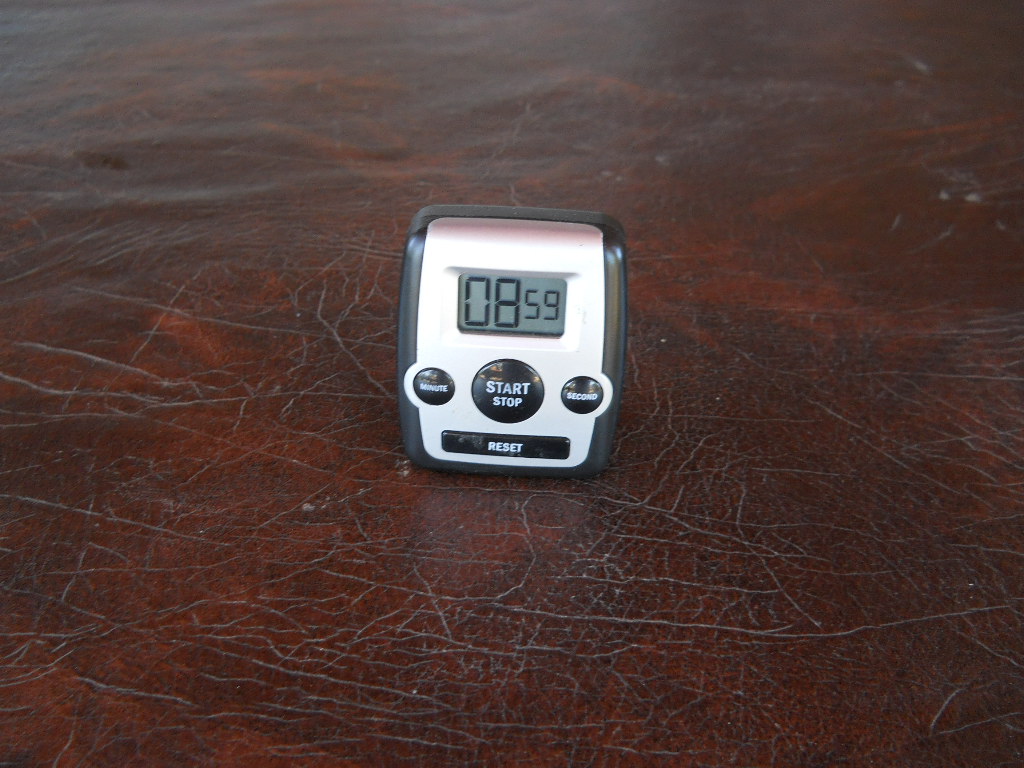
Check heat every ten minutes, ten degrees/10 minutes to 200º.
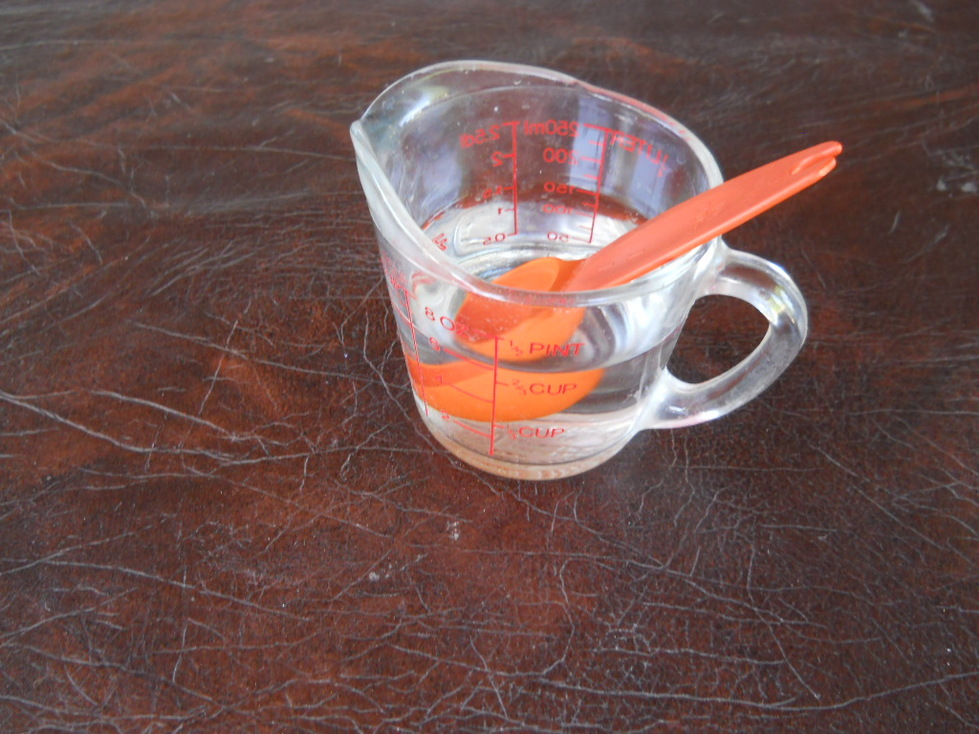
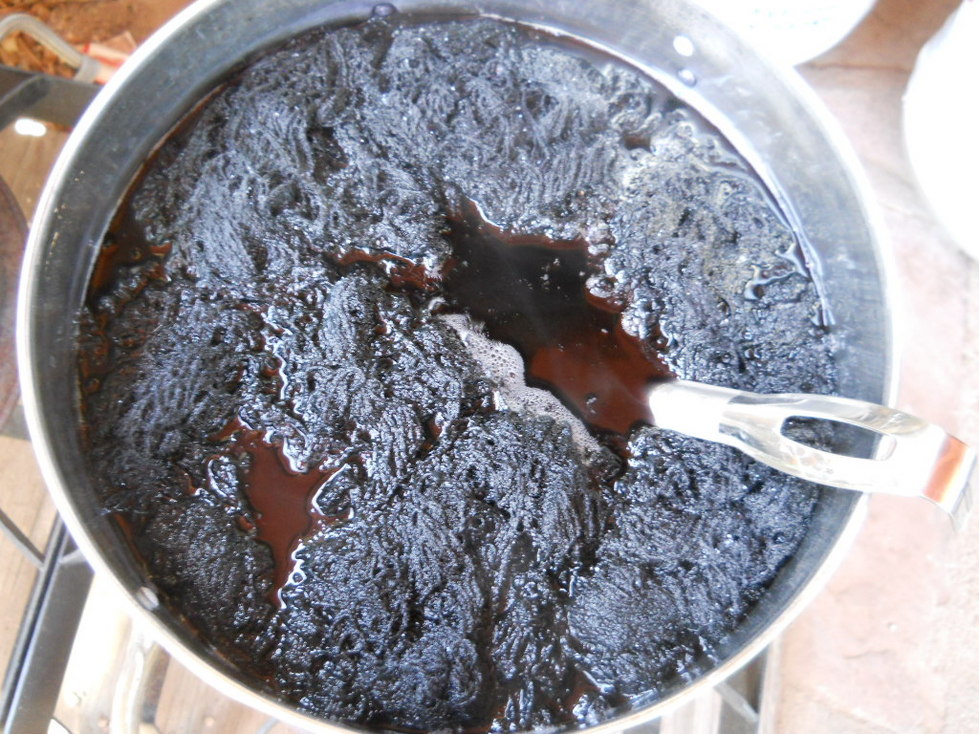
Add acetic acid
Boil gently for 30 minutes
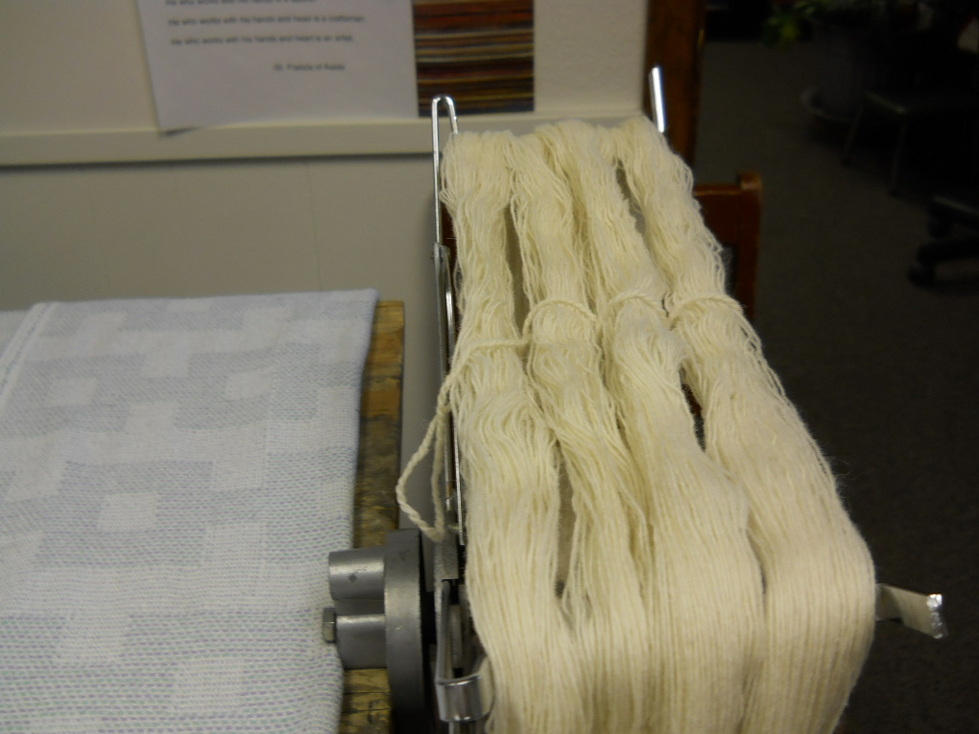
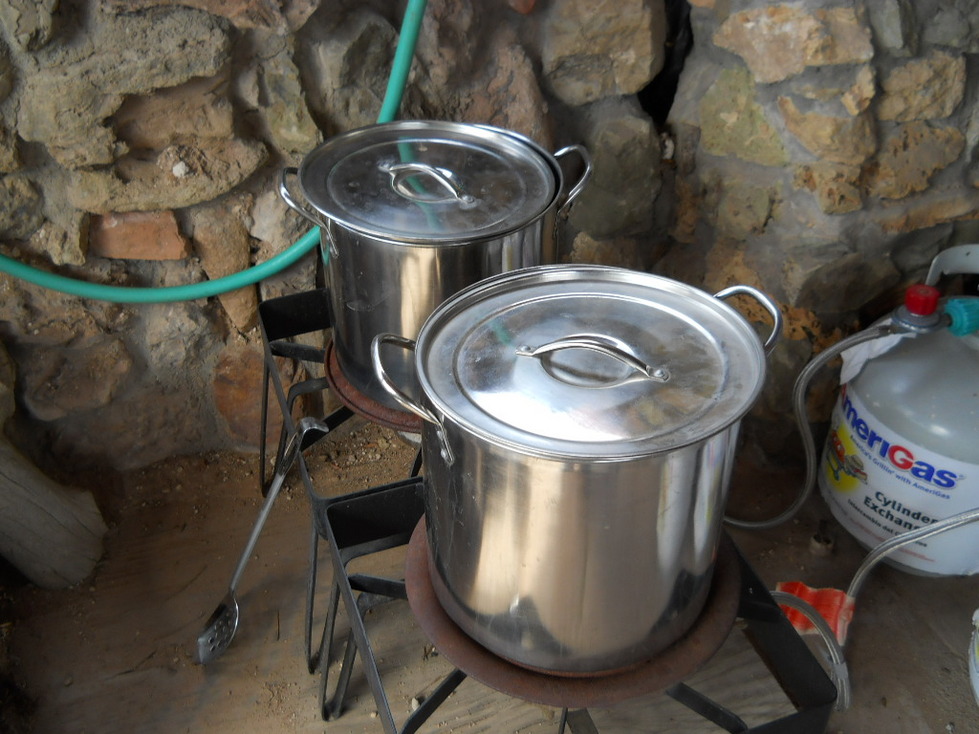
Overnight in dye bath
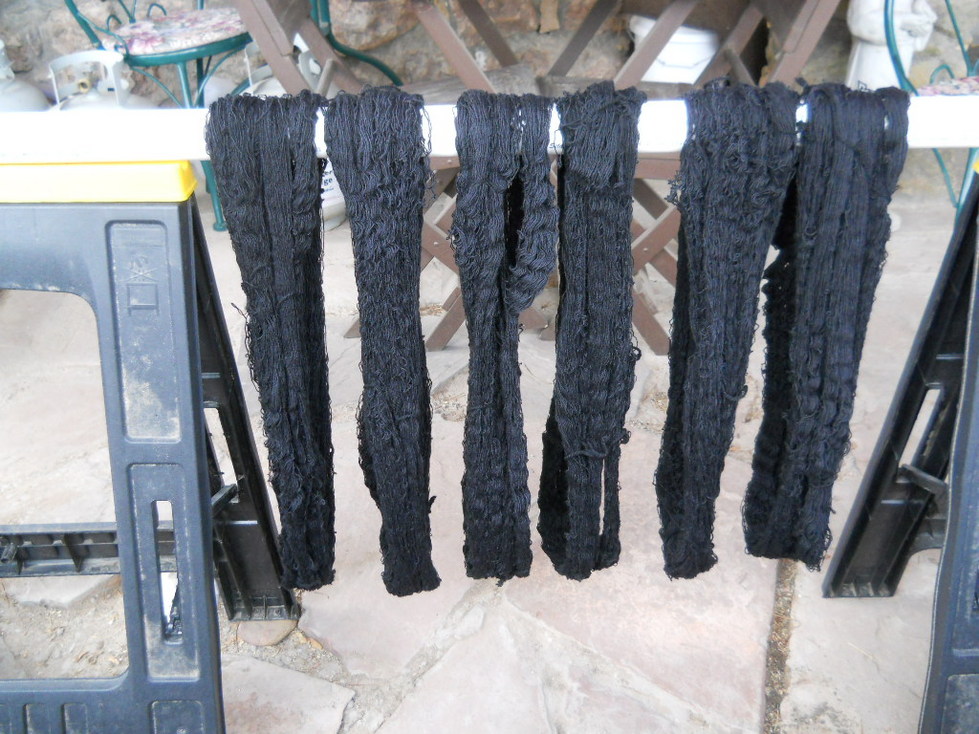
Rinse & hang to dry
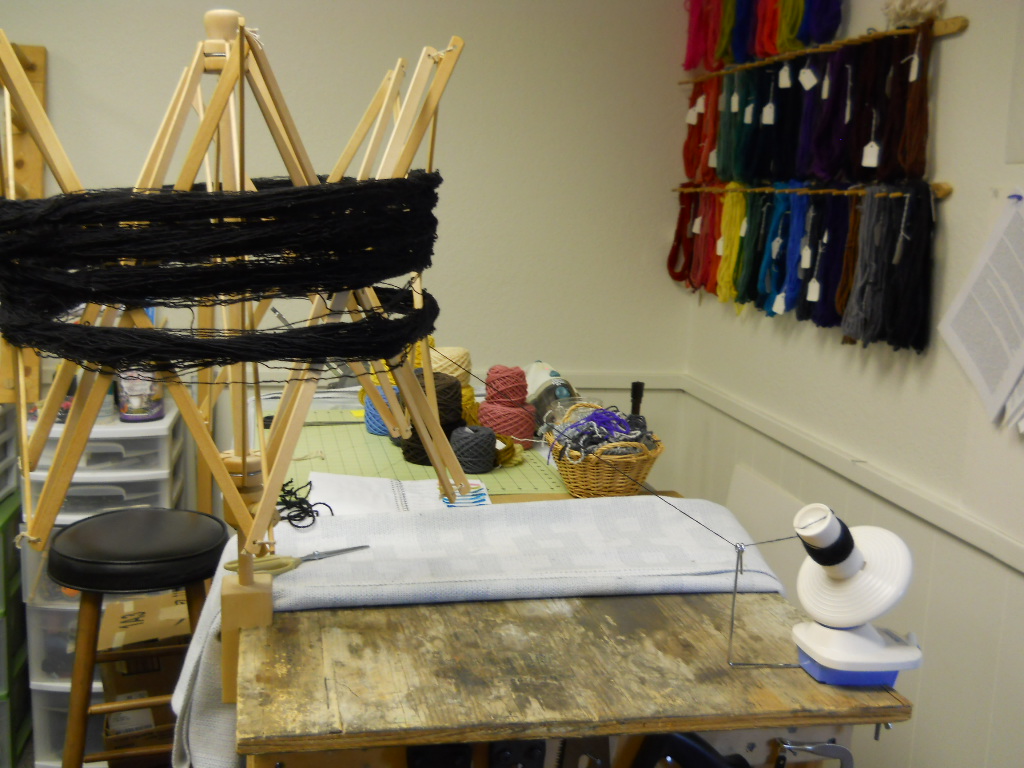
Winding into balls
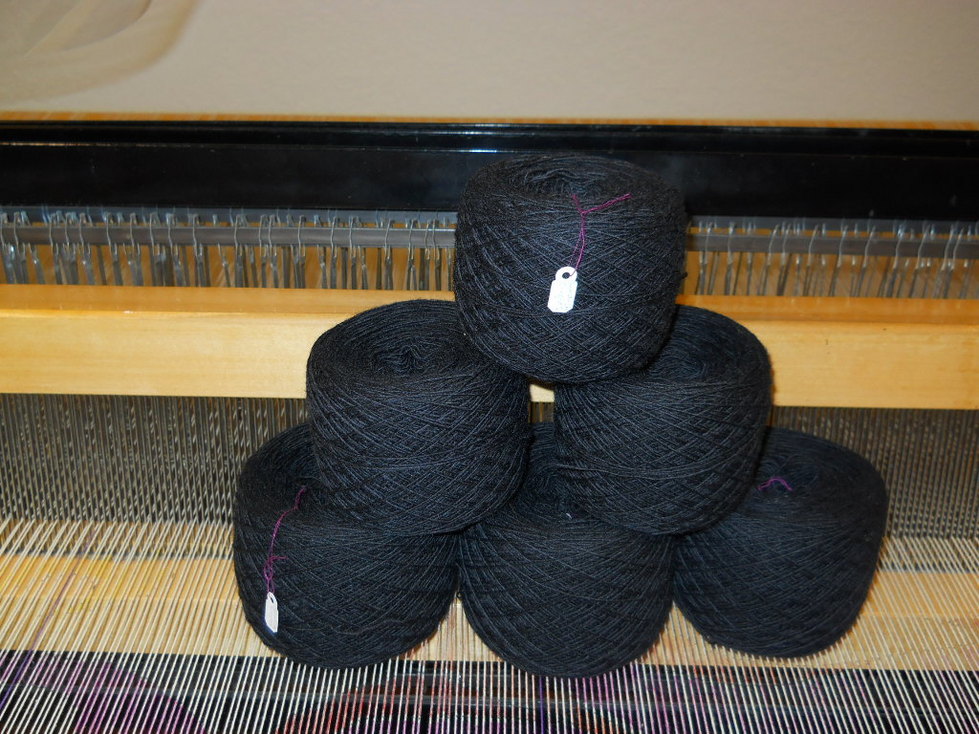
Tagged w/ yarn type, dye formula. Ready to weave.
When the piece is finally off the loom it has to rest for 1 to 3 days or more, depending on the size. This allows the cotton warp to relax from being under tension for so long.
Most tapestries will have slits. This is common to the weaving process. Some slits are left unsewn. Long vertical slits must be sewn together to preserve the integrity of the piece. One warp thread on each side of the slit is caught with the needle and thread in a figure 8. This continues to the end of the slit.
Once the tails and slits are finished the tapestry is blocked, if necessary, and steamed. This must be done before the final finishing.
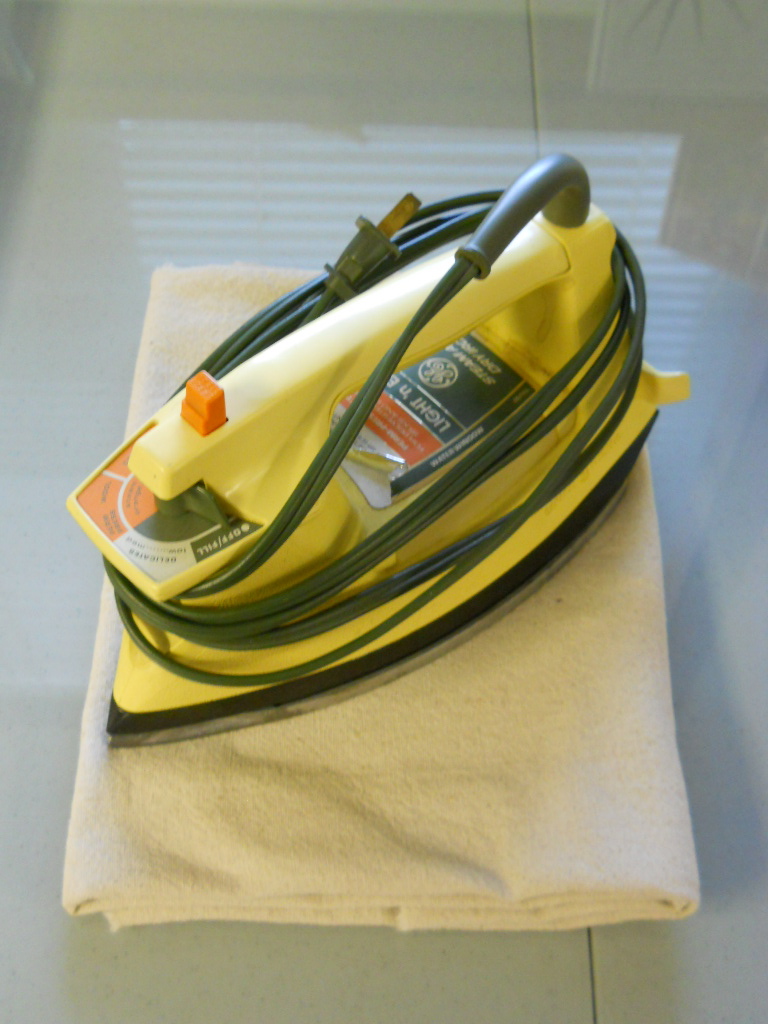
Iron & Pressing cloth
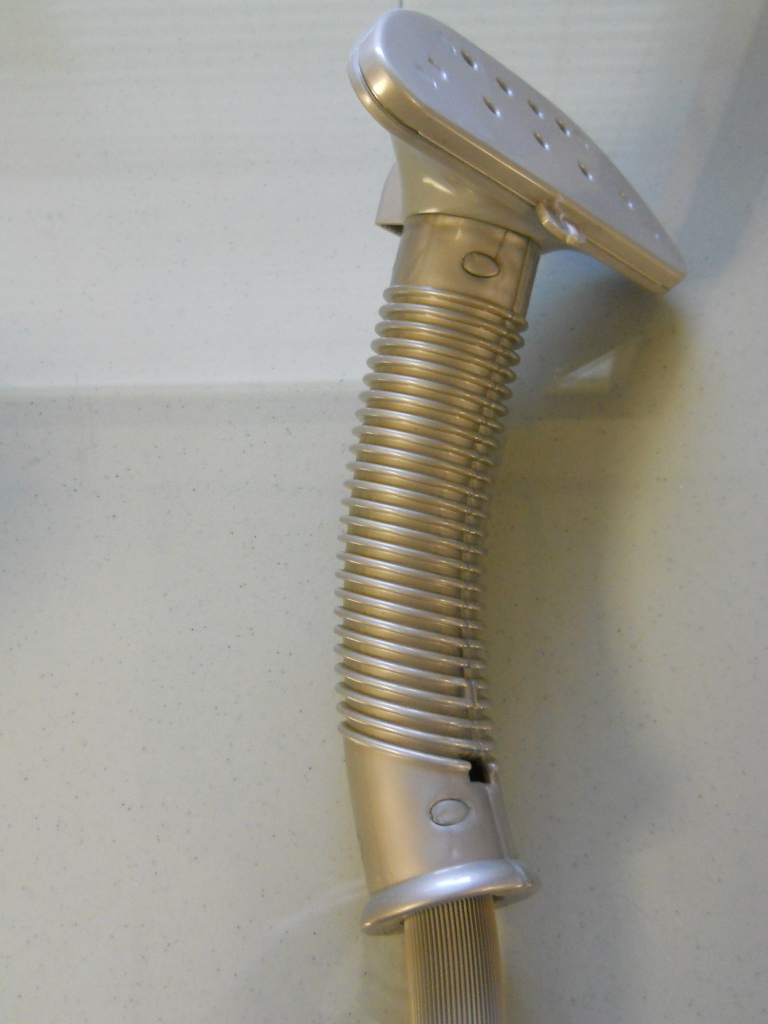
Hand-held Steamer
Twill tape and Velcro are machine stitched onto the hems of the tapestry, securing the warp ends in place.
Any person and/or institution and/or Agent and/or Agency of any governmental structure including but not limited to the United States Federal Government also using or monitoring/using this website or any of its associated websites, you DO NOT have my permission to utilize any of my profile information nor any of the content contained herein including, but not limited to my photos, and.../or the comments made about my photos or any other "picture" art posted on my profile. You are hereby notified that you are strictly prohibited from disclosing, copying, distributing, disseminating, or taking any other action against me with regard to this profile and the contents herein. The foregoing prohibitions also apply to your employee, agent, student or any personnel under your direction or control the contents of this profile are private and legally privileged and confidential information, and the violation of my personal privacy is punishable by law. UCC 1-103 1-308 ALL RIGHTS RESERVED WITHOUT PREJUDICE
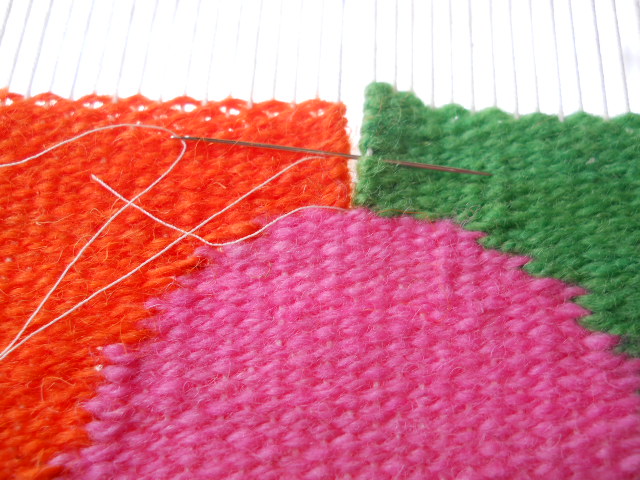
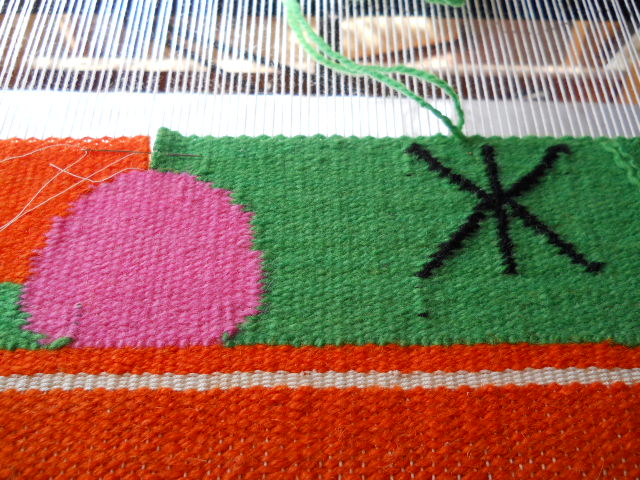
Sewing in the tails of yarn on the backside leaves a clean finish.
